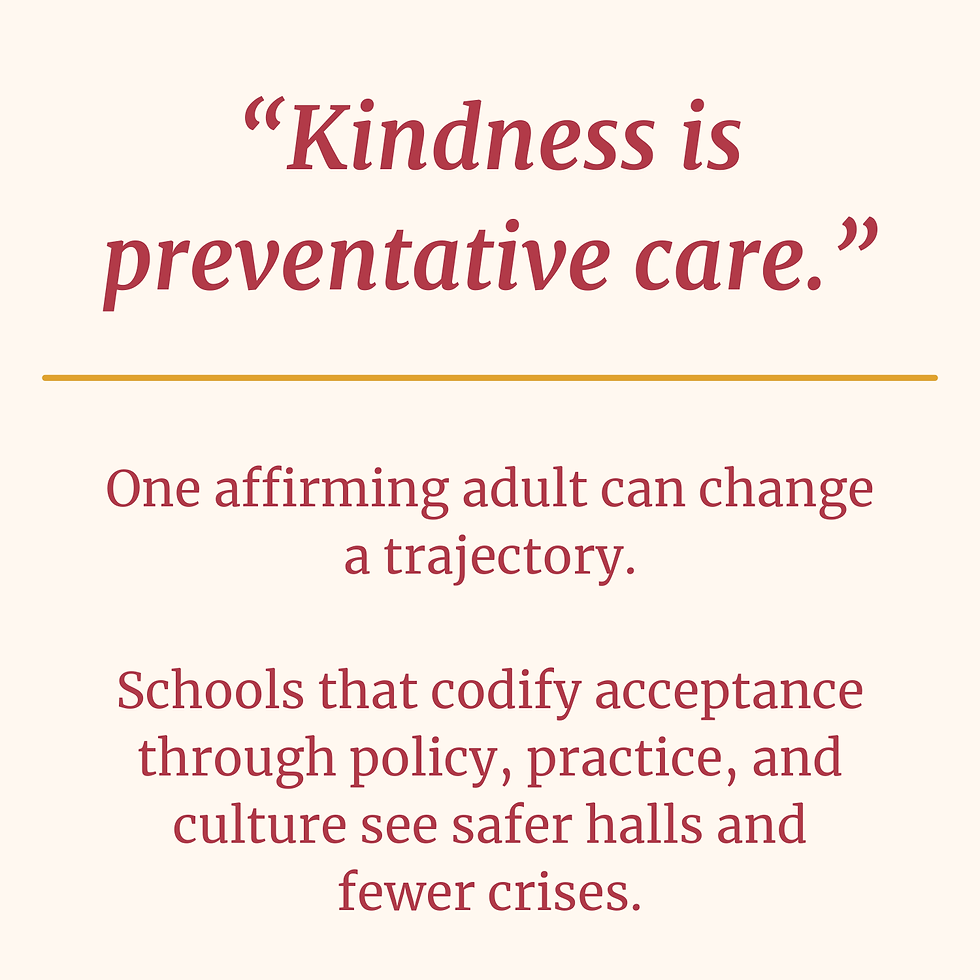Truth, Data, & Love — Preventing School Violence
- Meridith Byrne
- Aug 29
- 5 min read

School violence isn’t stopped by scapegoating — it’s stopped by truth, data, and love.
A disturbing trend has emerged in the aftermath of Minneapolis' Annunciation Parish shooting: commentators seizing on the shooter’s transgender identity to fuel culture-war attacks. This is speculative, inaccurate, and dangerous. The evidence is clear: supportive school climates, targeted prevention, and reduced access to lethal means save lives.
Scapegoating trans kids does not prevent school violence. Stop it.
Myths Busted
Myth 1: “Trans shooters are a growing trend.”
Fact: Mass shooters are overwhelmingly cisgender men.
Since 1966, 98% of public mass shooters have been male and cisgender.
Claims of a trans surge are misinformation.
Myth 2: “Gender-affirming acceptance makes youth unstable or violent.”
Fact: Acceptance reduces risk.
For trans and nonbinary youth, acceptance by even one adult is linked to a 33% lower risk of suicide attempts.
Using a youth’s chosen name across settings correlates with lower depression and suicidality.
Myth 3: “Anti-bullying is feel-good fluff; discipline stops violence.”
Fact: Zero-tolerance and harsh discipline don’t prevent attacks.
Evidence-based anti-bullying programs and restorative practices reduce bullying, improve climate, and cut suspensions.
Myth 4: “It’s all mental health—guns aren’t the issue.”
Fact: Access to firearms is one of the strongest predictors of violence.
Having a gun in the home triples suicide risk.
Secure storage and restricted access save lives.
Myth 5: “School attacks can’t be prevented.”
Fact: The U.S. Secret Service has documented that targeted school violence is often preventable.
Many attackers leak their plans in advance.
With trained teams and a supportive school system, interventions can and do stop attacks.
What Works: An Action Menu for Schools & Districts

Real solutions exist, and they’re backed by decades of research. The strategies below are concrete, evidence-based practices that schools and districts can implement to reduce violence, improve climate, and protect kids.
Adopt enumerated anti-bullying policies
Policies must explicitly name protections for sexual orientation, gender identity, and gender expression. Generic policies underperform.
Support GSAs (Gender & Sexuality Alliances)
Schools with GSAs report lower victimization and better climates—not just for LGBTQ students but across the board.
Train every adult in LGBTQ-affirming practice
Simple actions—using names/pronouns, intervening in bullying—make students safer.
Implement restorative practices with fidelity
Research shows restorative approaches reduce suspensions and racial disparities while improving school climate.
Adopt proven climate and anti-bullying programs
Programs like PBIS, KiVa, Olweus, and Second Step reduce bullying by 15–19% on average.
Create multidisciplinary threat-assessment teams
Teams focused on support (not punishment) identify and manage risks before violence occurs.
Normalize chosen names and pronouns
This is low-cost, high-impact suicide prevention. Quick correction should be standard.
Tighten access to lethal means
Secure storage campaigns and temporary transfer options during crises save lives.
Expand student mental health access
Digital crisis services and visible pathways for help-seeking reduce stigma and increase use.
Measure and iterate
Annual climate surveys, disaggregated by subgroup, help schools stay accountable.
Ask Your School Board
If you’re a parent, educator, or community member, one of the most powerful steps you can take is to hold your local school board accountable. Change happens fastest when the community insists on it, and boards respond to clear, concrete questions. Right now, anti-trans interests are petitioning those same boards with messages of fear and hate; it’s our responsibility to show up with truth, data, and love. We can advocate for measurable policies and practices that directly impact student safety and wellbeing. Here’s where to start:
Do our policies explicitly name SOGIE (sexual orientation, gender identity, and gender expression) protections?
Enumerated policies send a clear message that all students are protected; research shows they are more effective at reducing bullying than generic policies.
Do we have a trained threat-assessment team integrated with MTSS (Multi-Tiered System of Supports)?
Teams that coordinate with academic and mental health supports can intervene early and prevent violence, rather than defaulting to punishment alone.
Which school climate or anti-bullying program are we implementing, and how are we tracking impact?
Programs like PBIS, KiVa, or Second Step only make a difference when chosen intentionally and measured for results.
Are GSAs (Gender & Sexuality Alliances) supported, and is staff trained annually in affirming practices?
GSAs reduce victimization and improve climate for all students, and trained staff are the frontline of safety and inclusion.
What’s our secure-storage communication plan for families?
Access to unsecured firearms triples the risk of suicide; clear school-family communication about safe storage saves lives.
Closing Thoughts
The Minnesota tragedy was not about gender identity. Please stop spreading misinformation.
It was about alienation, untreated despair, access to guns, and extremist ideologies. Amplifying anti-trans rhetoric only distracts from real solutions and harms kids who are already at risk.
Right now, anti-trans voices are working overtime to flood school boards with fear. If we want to prevent violence, we must answer with truth, data, and love. Every community member has a role: showing up, asking the hard questions, and insisting on policies that make schools safer for all children. That’s how we build schools where every student feels safe, seen, and supported.
That's how we prevent school violence.
Sources & Further Reading

Media literacy matters, especially when lives and policies are on the line. I encourage you not to take my word—or anyone’s—at face value. Check my claims, check the studies, and then hold the politicians, pundits, and talking heads to the same standard. The research is clear, and it points in a very different direction than the scapegoating you may be hearing.
Bibliography
Anderson, M., & Tumlinson, L. (2021). The Violence Project Database of Mass Shootings in the United States, 1966–2020. The Violence Project. https://www.theviolenceproject.org/
Associated Press. (2023, March 29). AP fact check: No evidence of transgender mass shooting trend. AP News. https://apnews.com/
Johns, M. M., Lowry, R., Andrzejewski, J., et al. (2019). Transgender identity and experiences of violence victimization, substance use, suicide risk, and sexual risk behaviors among high school students—19 states and large urban school districts, 2017. Morbidity and Mortality Weekly Report, 68(3), 67–71. https://doi.org/10.15585/mmwr.mm6803a3
Kosciw, J. G., Clark, C. M., Truong, N. L., & Zongrone, A. D. (2020). The 2019 National School Climate Survey. GLSEN. https://www.glsen.org/research
Olson, K. R., Durwood, L., DeMeules, M., & McLaughlin, K. A. (2016). Mental health of transgender children who are supported in their identities. Pediatrics, 137(3), e20153223. https://doi.org/10.1542/peds.2015-3223
Russell, S. T., Pollitt, A. M., Li, G., & Grossman, A. H. (2018). Chosen name use is linked to reduced depressive symptoms, suicidal ideation, and suicidal behavior among transgender youth. Journal of Adolescent Health, 63(4), 503–505. https://doi.org/10.1016/j.jadohealth.2018.02.003
Steinberg, M. P., & Lacoe, J. (2018). Improving school climate through restorative practices: A randomized controlled trial. RAND Corporation. https://doi.org/10.7249/RR2840
Ttofi, M. M., & Farrington, D. P. (2011). Effectiveness of school-based anti-bullying programs: A systematic review and meta-analysis. Journal of Experimental Criminology, 7(1), 27–56. https://doi.org/10.1007/s11292-010-9109-1
U.S. Secret Service, National Threat Assessment Center (2019). Protecting America’s Schools: A U.S. Secret Service Analysis of Targeted School Violence. https://www.secretservice.gov/protection/ntac
Anglemyer, A., Horvath, T., & Rutherford, G. (2014). The accessibility of firearms and risk for suicide and homicide victimization among household members: A systematic review and meta-analysis. Annals of Internal Medicine, 160(2), 101–110. https://doi.org/10.7326/M13-1301
.png)









Comments